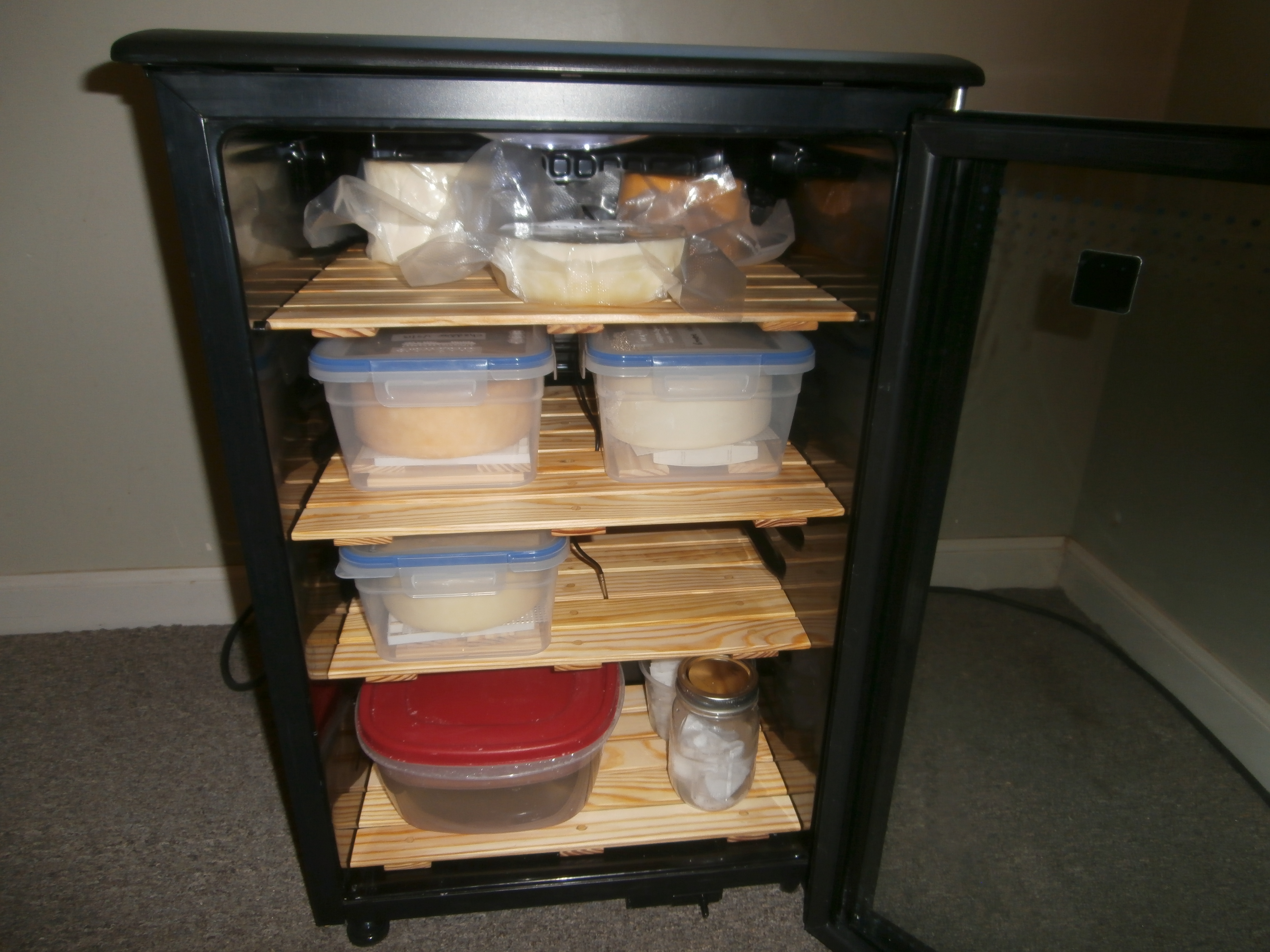You are using an out of date browser. It may not display this or other websites correctly.
You should upgrade or use an alternative browser.
You should upgrade or use an alternative browser.
Cheese Cave build
- Thread starter passedpawn
- Start date

Help Support Homebrew Talk:
This site may earn a commission from merchant affiliate
links, including eBay, Amazon, and others.
I have finally found time to work on my cheese cave. The shelves are almost done, I just need to dowel them together. I was wondering if Elmer's glue would be OK or if a waterproof glue would be needed.
I'd definitely use waterproof wood glue. I use Titebond III, but I'm pretty sure all wood glues would work.
Agree with Andrew totally. Go with Titebond III. Titebond II will work as well, but with the humidity of a cheese cave you will want a waterproof glue.
Cheeses develop properly at around 55F. A wine fridge is a good size and right temperature for cheeses. I don't even have a temperature controller on mine (though I might get one soon).
It's a good idea to have a temperature and humidity sensor in there. Lots of cheap wireless ones available.
This wine fridge is a 2.5 cuft one that I got off craigslist for $30. It's perfect for me. I made my own shelves for it (replaced the wire wine shelves that are not flat and basically useless for cheeses).
So you think 55F is a good general purpose temp? I just ordered a lot of cheese making supplies and intend to start in the next 1-2 weeks. I have a large mini fridge, that is not quite big enough for kegs I plan to use. A lot of the recipes I see, call for temps all over the place, 38-65F. I wasn't sure if it's like beer, where 1-2 degrees makes a big difference sometimes. I plan to make a variety of cheeses but any blue/penicillin would be my preference.
So you think 55F is a good general purpose temp? I just ordered a lot of cheese making supplies and intend to start in the next 1-2 weeks. I have a large mini fridge, that is not quite big enough for kegs I plan to use. A lot of the recipes I see, call for temps all over the place, 38-65F. I wasn't sure if it's like beer, where 1-2 degrees makes a big difference sometimes. I plan to make a variety of cheeses but any blue/penicillin would be my preference.
I'm no expert for sure, but that sounds perfect. Generally, the recipes I follow call for 50-60F. My wine fridge stays between 55 and 60F, so I just go with that. I never adjust the temperature. If you've seen my posts here, you'll see that I make a pretty good blue cheese.
With some cheeses, AFTER the fermentation, you want to arrest development by getting them to 35F (fridge). For example, camemberts will go from soft cheese to goo quickly if not put in the fridge as soon as the fuzzy rind appears.
Good info. I just need to get a wine fridge and I am all set to go to start making some of these recipes.
John
John

$10.99 ($31.16 / Ounce)
Hornindal Kveik Yeast for Homebrewing - Mead, Cider, Wine, Beer - 10g Packet - Saccharomyces Cerevisiae - Sold by Shadowhive.com
Shadowhive

$7.79 ($7.79 / Count)
Craft A Brew - LalBrew Voss™ - Kveik Ale Yeast - For Craft Lagers - Ingredients for Home Brewing - Beer Making Supplies - (1 Pack)
Craft a Brew

$58.16
HUIZHUGS Brewing Equipment Keg Ball Lock Faucet 30cm Reinforced Silicone Hose Secondary Fermentation Homebrew Kegging Brewing Equipment
xiangshuizhenzhanglingfengshop

$176.97
1pc Commercial Keg Manifold 2" Tri Clamp,Ball Lock Tapping Head,Pressure Gauge/Adjustable PRV for Kegging,Fermentation Control
hanhanbaihuoxiaoshoudian

$53.24
1pc Hose Barb/MFL 1.5" Tri Clamp to Ball Lock Post Liquid Gas Homebrew Kegging Fermentation Parts Brewer Hardware SUS304(Liquid Hose Barb)
Guangshui Weilu You Trading Co., Ltd

$49.95 ($0.08 / Fl Oz)
$52.99 ($0.08 / Fl Oz)
Brewer's Best - 1073 - Home Brew Beer Ingredient Kit (5 gallon), (Blueberry Honey Ale) Golden
Amazon.com

$33.99 ($17.00 / Count)
$41.99 ($21.00 / Count)
2 Pack 1 Gallon Large Fermentation Jars with 3 Airlocks and 2 SCREW Lids(100% Airtight Heavy Duty Lid w Silicone) - Wide Mouth Glass Jars w Scale Mark - Pickle Jars for Sauerkraut, Sourdough Starter
Qianfenie Direct

$22.00 ($623.23 / Ounce)
AMZLMPKNTW Ball Lock Sample Faucet 30cm Reinforced Silicone Hose Secondary Fermentation Homebrew Kegging joyful
无为中南商贸有限公司

$20.94
$29.99
The Brew Your Own Big Book of Clone Recipes: Featuring 300 Homebrew Recipes from Your Favorite Breweries
Amazon.com

$53.24
1pc Hose Barb/MFL 1.5" Tri Clamp to Ball Lock Post Liquid Gas Homebrew Kegging Fermentation Parts Brewer Hardware SUS304(Liquid MFL)
yunchengshiyanhuqucuichendianzishangwuyouxiangongsi
I'm no expert for sure, but that sounds perfect. Generally, the recipes I follow call for 50-60F. My wine fridge stays between 55 and 60F, so I just go with that. I never adjust the temperature. If you've seen my posts here, you'll see that I make a pretty good blue cheese.
With some cheeses, AFTER the fermentation, you want to arrest development by getting them to 35F (fridge). For example, camemberts will go from soft cheese to goo quickly if not put in the fridge as soon as the fuzzy rind appears.
Thanks, my supplies came in today. Starting with Queso Fresco this weekend, I'm pretty excited. I'm going to pick up a temp controller for the mini fridge.
Thanks, my supplies came in today. Starting with Queso Fresco this weekend, I'm pretty excited. I'm going to pick up a temp controller for the mini fridge.
Good luck!
shelly_belly
Someday After A While
Thanks, my supplies came in today. Starting with Queso Fresco this weekend, I'm pretty excited. I'm going to pick up a temp controller for the mini fridge.
This was my first cheese. I made it plain. I did not like it, it was just too bland. I took what I had, vacuum bagged it and tossed it in the vegetable crisper in the fridge. I forgot about it. I found it a month ago when it was 12 months old. Now it tastes like Cabot's Seriously Sharp Cheddar!
Finally got my cheese cave built . The thermostat didn't work right so I replaced it with a MH1210F. I have a Colby, Gruyere, Romano, Butterkase and a cloth banded Cheddar aging.View attachment 607271
That's pretty fantastic.
user 246304
Well-Known Member
- Joined
- Aug 24, 2017
- Messages
- 8,290
- Reaction score
- 9,851
Agreed. Nice, Dave!
Very cool Dave!!
user 246304
Well-Known Member
- Joined
- Aug 24, 2017
- Messages
- 8,290
- Reaction score
- 9,851
Sorry for reviving an old one guys (Andrew, again, nice one!). Can't recall if I mentioned it, but a new to me, very lightly used Magic Chef "45 bottle" tanked after about a month. Bummed, as it was really working as a natural rind, Savoie cave with grey mucor, P. blanc, lots of other beasties from the way these rustic tommes were developing. Coolest thing ever - long "fur," "poils du chat." Exactly like tommes de Savoie progress from yeast to geo to these molds to corynes/red and yellow.
Anyway, I wanted to give the starter relay a try, too. But for some reason, the lowest I've found is $22, and Amazon is $35 (not prime) to $41. I bought the cave for $40 and it doesn't make much sense to spend more on this little part than the cost of the cooler itself. Isn't that weirdly high? I see in the range $11-14 typically. Any suggestions? BTW, the part is Magic Chef/E-Wave 312200500017. Thanks.
Anyway, I wanted to give the starter relay a try, too. But for some reason, the lowest I've found is $22, and Amazon is $35 (not prime) to $41. I bought the cave for $40 and it doesn't make much sense to spend more on this little part than the cost of the cooler itself. Isn't that weirdly high? I see in the range $11-14 typically. Any suggestions? BTW, the part is Magic Chef/E-Wave 312200500017. Thanks.
Sorry for reviving an old one guys (Andrew, again, nice one!). Can't recall if I mentioned it, but a new to me, very lightly used Magic Chef "45 bottle" tanked after about a month. Bummed, as it was really working as a natural rind, Savoie cave with grey mucor, P. blanc, lots of other beasties from the way these rustic tommes were developing. Coolest thing ever - long "fur," "poils du chat." Exactly like tommes de Savoie progress from yeast to geo to these molds to corynes/red and yellow.
Anyway, I wanted to give the starter relay a try, too. But for some reason, the lowest I've found is $22, and Amazon is $35 (not prime) to $41. I bought the cave for $40 and it doesn't make much sense to spend more on this little part than the cost of the cooler itself. Isn't that weirdly high? I see in the range $11-14 typically. Any suggestions? BTW, the part is Magic Chef/E-Wave 312200500017. Thanks.
Suck! My own wine fridge died (again). Not sure how long it was 90F+, but the two full wheels of aged romano turned an odd tan color. They are vac sealed. I also saved a bi-color colby that was in there that lost a lot of whey into the bag. The rest of the cheeses looked like a mess and I tossed. Argh. I will open them this weekend and see how deep the damage is.
Anyway, my starter relay was only $13 so I'll probably get another. I might also change the starter cap if I can figure out which one to buy. The startup problem could be either I guess.
Hobbies are so much fun!
user 246304
Well-Known Member
- Joined
- Aug 24, 2017
- Messages
- 8,290
- Reaction score
- 9,851
Suck! My own wine fridge died (again). Not sure how long it was 90F+, but the two full wheels of aged romano turned an odd tan color. They are vac sealed. I also saved a bi-color colby that was in there that lost a lot of whey into the bag. The rest of the cheeses looked like a mess and I tossed. Argh. I will open them this weekend and see how deep the damage is.
Anyway, my starter relay was only $13 so I'll probably get another. I might also change the starter cap if I can figure out which one to buy. The startup problem could be either I guess.
Hobbies are so much fun!
Andrew as you know, I am not exactly gifted mechanically. I'm running 97% RH and there's a ton of condensation. I thought I remember somewhere someone talking about waterproofing cables or something like that. Or the starter relay itself? Is that what you're talking about, with the starter cap? To your knowledge, should we silicone anything coming in? (Can't even recall if I have anything - thermo cooling).
Andrew as you know, I am not exactly gifted mechanically. I'm running 97% RH and there's a ton of condensation. I thought I remember somewhere someone talking about waterproofing cables or something like that. Or the starter relay itself? Is that what you're talking about, with the starter cap? To your knowledge, should we silicone anything coming in? (Can't even recall if I have anything - thermo cooling).
97% RH? Woah. I don't think mine ever gets above 70.
The inside doesn't need any waterproofing, but since it's going to be humid, you'll want to mind electronics of course. And, if you build shelves, don't use anything that would rust.
I'll update this thread when I get mine operational again. I've been meaning to get back to cheesemaking (haven't made any in months).
Suck! My own wine fridge died (again). Not sure how long it was 90F+, but the two full wheels of aged romano turned an odd tan color. They are vac sealed. I also saved a bi-color colby that was in there that lost a lot of whey into the bag. The rest of the cheeses looked like a mess and I tossed. Argh. I will open them this weekend and see how deep the damage is.
Anyway, my starter relay was only $13 so I'll probably get another. I might also change the starter cap if I can figure out which one to buy. The startup problem could be either I guess.
Hobbies are so much fun!
They are both pretty easy to test, but also pretty cheap to replace. Could be a problem with the actual compressor too.
user 246304
Well-Known Member
- Joined
- Aug 24, 2017
- Messages
- 8,290
- Reaction score
- 9,851
97% RH? Woah. I don't think mine ever gets above 70.
The inside doesn't need any waterproofing, but since it's going to be humid, you'll want to mind electronics of course. And, if you build shelves, don't use anything that would rust.
I'll update this thread when I get mine operational again. I've been meaning to get back to cheesemaking (haven't made any in months).
Andrew, I spaced, just noticed your cave went on the fritz again, sorry man. Hope you do get back in, love to see some cheese. I'm always thinking weird things. Ideally I'll have a washed rind, a natural rind (e.g., tommes), a bloomy, a brine/attemperation and a drying ("sechage") cave. All radiant cooling, a DIY cooling system with an AC. I have a very stout pump for the coolant reservoir, and a spare AC, so we'll see.
Sorry for reviving an old one guys (Andrew, again, nice one!). Can't recall if I mentioned it, but a new to me, very lightly used Magic Chef "45 bottle" tanked after about a month. Bummed, as it was really working as a natural rind, Savoie cave with grey mucor, P. blanc, lots of other beasties from the way these rustic tommes were developing. Coolest thing ever - long "fur," "poils du chat." Exactly like tommes de Savoie progress from yeast to geo to these molds to corynes/red and yellow.
Anyway, I wanted to give the starter relay a try, too. But for some reason, the lowest I've found is $22, and Amazon is $35 (not prime) to $41. I bought the cave for $40 and it doesn't make much sense to spend more on this little part than the cost of the cooler itself. Isn't that weirdly high? I see in the range $11-14 typically. Any suggestions? BTW, the part is Magic Chef/E-Wave 312200500017. Thanks.
It's possible you can fix your relay. I just fixed mine. It's running fine right now.
The "relay" isn't really a conventional relay. Inside, mine had a disk of PTC material. This material is conductive (~5 ohms) at room temperature. I took mine apart (no tools required!) and found that the area where the springy contacts touched it were pitted and fouled, and the resulting resistance was high (> 50k ohms). If you open yours up, rotate the disk so the contact touches a good spot (you can see the bad spot there), and use a bit of sandpaper on the contact to remove any carbon, it'll work fine again.
This might be an indication of some other problem (like a compressor that is sticking/failing). Who knows.
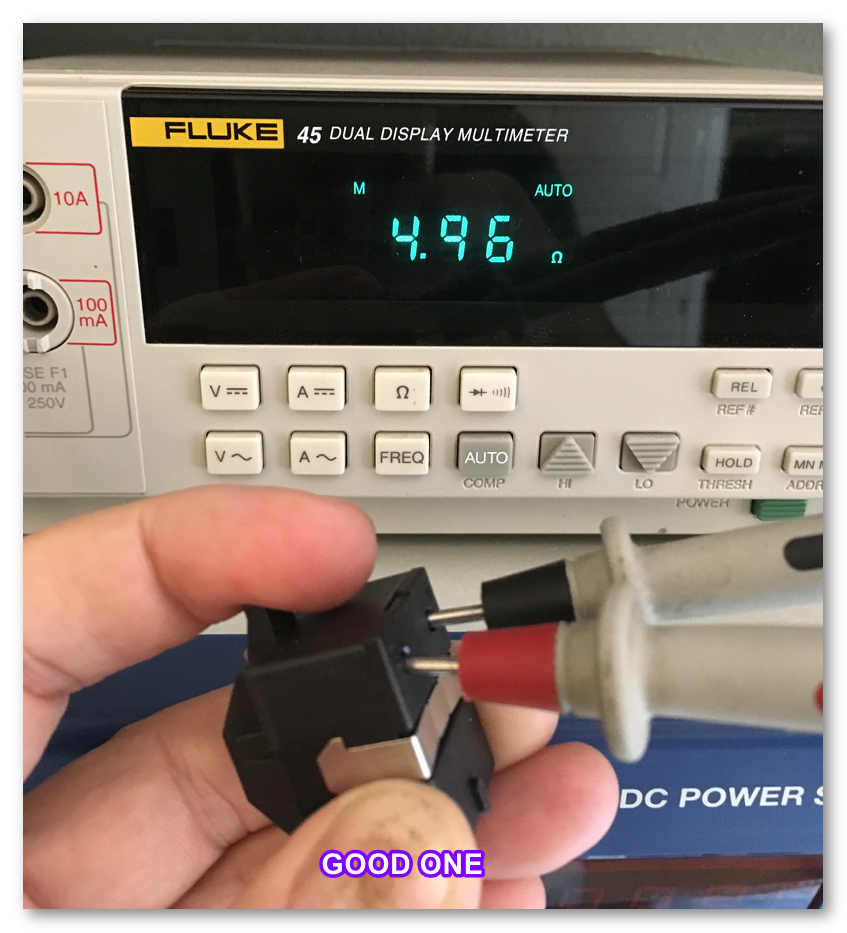
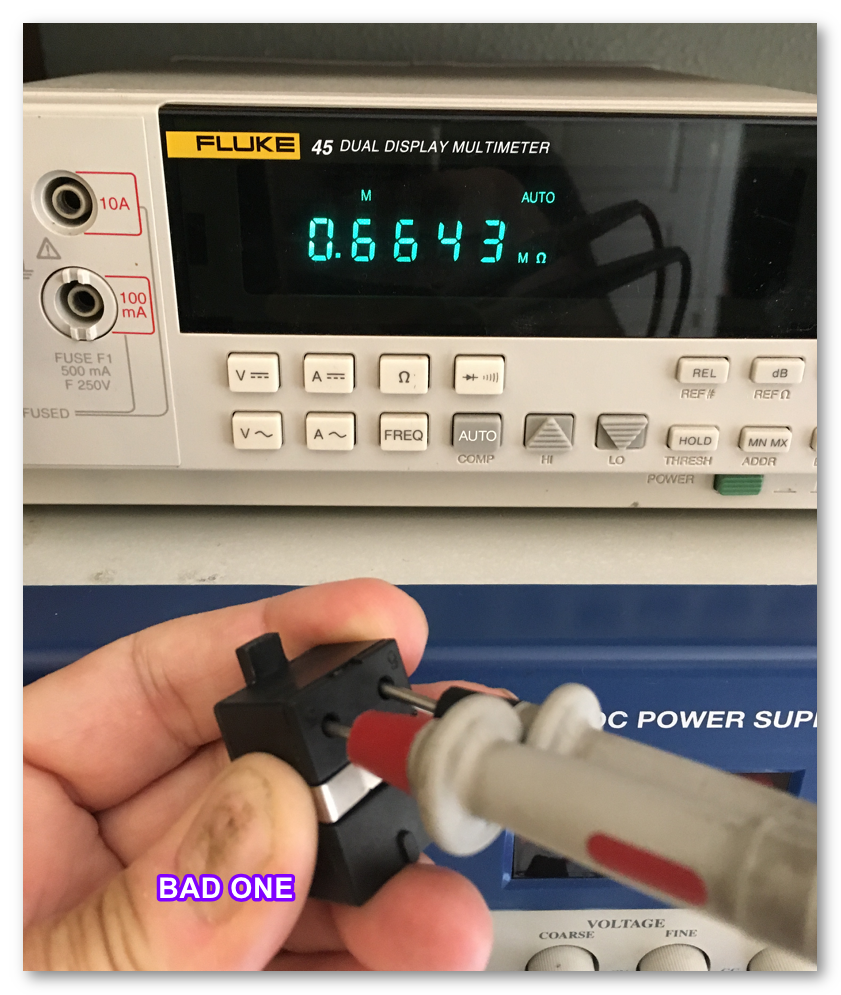

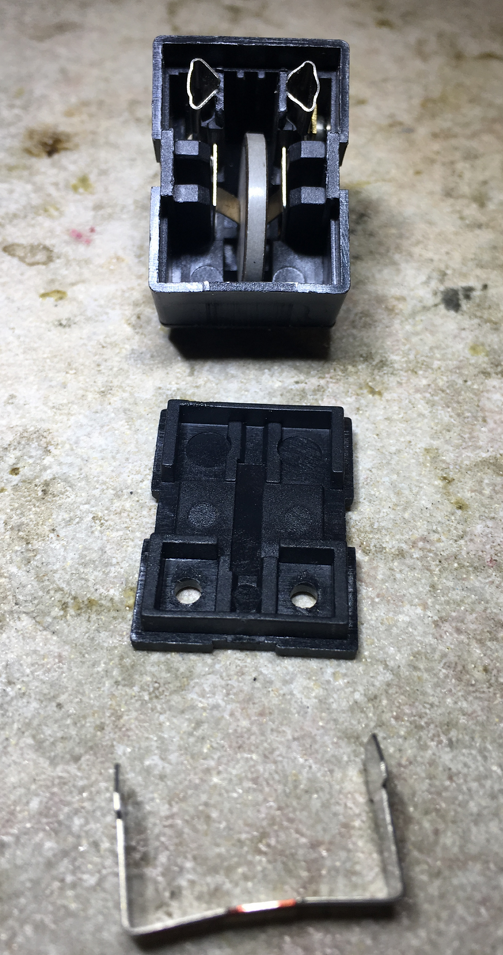
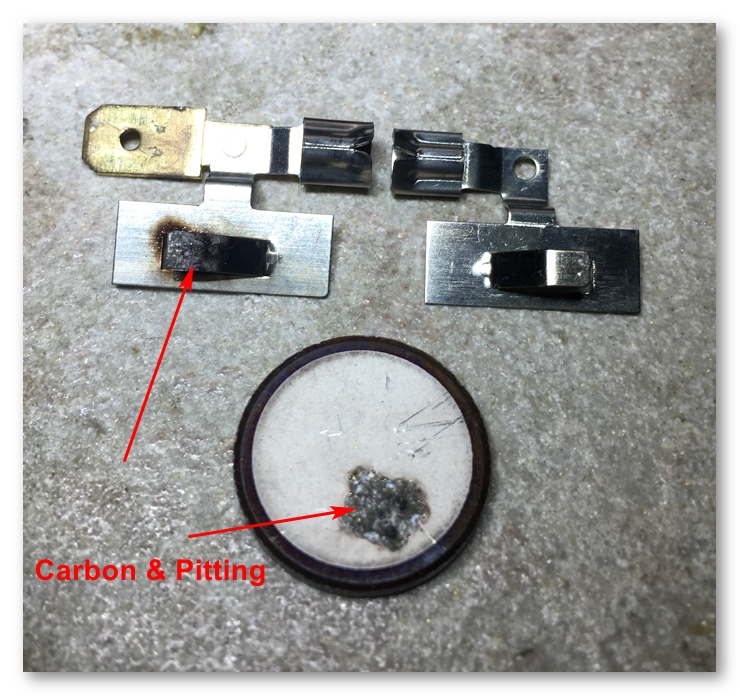
shelly_belly
Someday After A While
Suck! My own wine fridge died (again)....
I feel your pain. My chest freezer/cave died a month ago. I had an 8" fan running in there and it must put out a lot of heat as the temperature was 120F. Melted my Port Salut, Belper Knolles, a Romano and a Parmesan. Not in a good way either. I was only washing/checking every 3 days, no telling how long it was out. When i get it going again I'm installing a temperature alarm.
I feel your pain. My chest freezer/cave died a month ago. I had an 8" fan running in there and it must put out a lot of heat as the temperature was 120F. Melted my Port Salut, Belper Knolles, a Romano and a Parmesan. Not in a good way either. I was only washing/checking every 3 days, no telling how long it was out. When i get it going again I'm installing a temperature alarm.
Here's an Edam I discovered yesterday in the back of my failed fridge (the fridge that is now cold again). I thought I got them all out, but this was in the back. I've got a bunch more that are like this. I'm going to taste them, but I suspect that due to the loss of all that liquid, they are going to be awful dry.

I feel your pain. My chest freezer/cave died a month ago. I had an 8" fan running in there and it must put out a lot of heat as the temperature was 120F. Melted my Port Salut, Belper Knolles, a Romano and a Parmesan. Not in a good way either. I was only washing/checking every 3 days, no telling how long it was out. When i get it going again I'm installing a temperature alarm.
I avoided putting fans in my freezers because I was always worried about adding additional heat. Didn't seem right. I guess my intuition was correct.
I avoided putting fans in my freezers because I was always worried about adding additional heat. Didn't seem right. I guess my intuition was correct.
You could maybe get away with a little USB fan like this one
https://www.amazon.com/OPOLAR-Speed...coding=UTF8&psc=1&refRID=CR7PK8JTSAMK3ZW215YT
You don't need much air circulation and that little fan is only 2.5 W. Not a lot of heat I would think.
Indeed a bummer. Is it a compressor unit or a thermoelectric?
Why is this important? I see that mentioned all the time. Is it the ones with compressors that are good? Or is it the other way around? I have no clue when it comes to electronics. So it would be nice if someone could explain why it should be compressor (or the other one).
Why is this important? I see that mentioned all the time. Is it the ones with compressors that are good? Or is it the other way around? I have no clue when it comes to electronics. So it would be nice if someone could explain why it should be compressor (or the other one).
They will both get the job done, but those TE coolers take a lot of power. I would not use one, especially in my FL garage.
Aha! OKThey will both get the job done, but those TE coolers take a lot of power. I would not use one, especially in my FL garage.
So the compressor-ones requires less electricity?
Which of the two are more silent normally?
Also those shelves that you built. You got them from home depot right? I don't have Home Depot here in Europe. But maybe I could use some other material ?
I like that your shelves looks like they have air coming in from beneath them as well.
Also, you posted two images of plastic boxes that you use for your cheese to keep humid(?). Do you have those completely sealed or do you keep a little bit of the lid open so that air can seep in there?
Aha! OK
So the compressor-ones requires less electricity?
Which of the two are more silent normally?
Also those shelves that you built. You got them from home depot right? I don't have Home Depot here in Europe. But maybe I could use some other material ?
I like that your shelves looks like they have air coming in from beneath them as well.
Also, you posted two images of plastic boxes that you use for your cheese to keep humid(?). Do you have those completely sealed or do you keep a little bit of the lid open so that air can seep in there?
TE is COMPLETELY silent. Models with compressors make very little sound also, but I wouldn't want it next to my bed.
Yes, I made those from wood slats and dowels. You could use any material, but I like the aesthetics and workability of wood. If there is any metal in the shelves, make sure it's not something that will rust.
For the shelves, just make sure they are vented with slots or holes. Cheese continues to expel whey when it's aging, and you want the whey to get away from the cheese to avoid mold and to let the rind develop properly.
When you are trying to keep humidity high, seal the boxes. It's the only way. Though, I do check them every day or two, so if there is any need for oxygen, it's getting replenished. Not really sure what the right answer is here - that's just how I do it.
When you are trying to keep humidity high, seal the boxes. It's the only way. Though, I do check them every day or two, so if there is any need for oxygen, it's getting replenished. Not really sure what the right answer is here - that's just how I do it.
Ok nice
Are those plastic sealers and boxes what people call "ripening boxes"?
About the sealers, are you using some type of vacuum bags? Or are they just ordinary plastic sealers? And where can I buy those?
And would ordinary plastic bags from any supermarket work just as well?
Or could even a plastic lunch box do the job perhaps?
So in a wine cooler, which is already humid from the extra glass of water(or something), that is put in there by the cheesemaker, the humidity might be perhaps 60-70%, right?
But the ripening boxes are going to keep an even higher moisture level than that right? Above 90% even maybe?
Similar threads
- Replies
- 17
- Views
- 1K
- Replies
- 23
- Views
- 2K
- Replies
- 1
- Views
- 1K
Latest posts
-
-
The Dysfunctional-Palooza Obnoxious Masshole BS Thread
- Latest: TheDudeLebowski
-
-
-
-
-


















![Craft A Brew - Safale S-04 Dry Yeast - Fermentis - English Ale Dry Yeast - For English and American Ales and Hard Apple Ciders - Ingredients for Home Brewing - Beer Making Supplies - [1 Pack]](https://m.media-amazon.com/images/I/41fVGNh6JfL._SL500_.jpg)



























